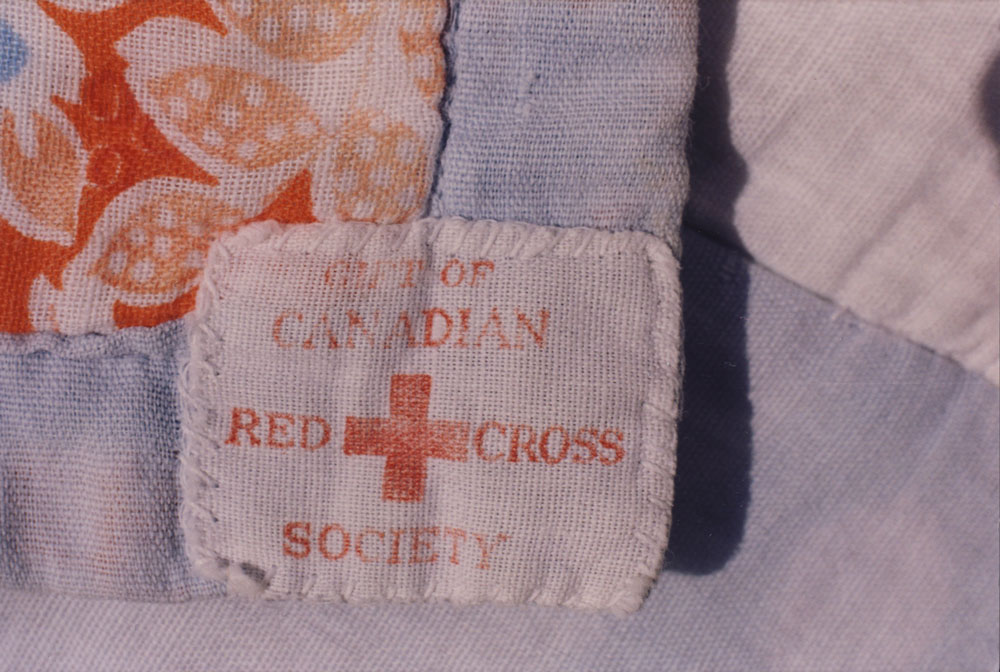“Canadian Comfort” quilts brought more than warmth to Britons
Comfort and care. Those are the words linked to the thousands of quilts made by women volunteers during the Second World War.
Of all the services that women provided for wartime relief, perhaps the making of quilts represented the most intimate expression of comfort and care for those suffering the horrors of war. Women all over Canada gathered to sew quilts for bombed-out families in Britain. Considering the labour involved, the act of making bedding that was both colourful and cozy went beyond providing the merely practical.
Often one-of-a kind works of beauty, the quilts are remembered with special fondness. As British quilt owner Clover Mack said: “We knew them as Canadian Comforts and comforts they were indeed.”
Stella Simmons was just one of thousands of recipients of Canadian Red Cross quilts during the war. “Our house was very badly damaged by a flying bomb – and had no roof, doors or windows,” she said. “Everyone hung onto their homes despite everything…. You can imagine our delight when the quilt was given to us. It was put to immediate use and has been in constant use ever since.”

Stella Simmons and her quilt (Courtesy of Stella Simmons, Milford-on-Sea, United Kingdom)
Pat Staple’s parents received a Canadian quilt: “My parents were given by Bath Red Cross one of the quilts – it was very pretty. I slept in a double bed with my sister. The quilt kept us very warm and we had lots of fun making up stories about the different patterns. We wished we had dresses in those fabric patterns. We were very grateful to receive it and I wish I still had it now.”
In addition to the distribution to civilians, the quilts were given to many service women and men. Doreen Palmer, who served in a Voluntary Aid Detachment (VAD) wrote, “I must say that the Barrack Room beds looked more attractive with all these quilts.”

Patchwork Quilt Photo and Red Cross label (Courtesy of Doreen Palmer, High Wycombe, United Kingdom)

Patchwork Quilt (Courtesy of Doreen Palmer, High Wycombe, United Kingdom)
Evelyn Gardiner, a nurse in training in the immediate post-war period remarked that, “All the beds in the Nurses Home had coloured patchwork quilts with labels on them saying they were gifted by the Canadian Red Cross. They were much appreciated because there were severe heating restrictions at that time.”
These are just a few examples of the stories collected from quilt recipients in Britain. But what of those from Nova Scotia who made those Red Cross quilts?
Louise Warne, a volunteer from Digby wrote: “Although Digby with a population of only about 2,000 had a relatively small (Red Cross) branch, what we lacked in numbers we made up in the activity and devotion of our members, thus our production of work was ranked 4th in the province.”
She also quoted from a Chronicle Herald source (Provincial Diary, July 1-7, 1943, by Lorna Inness): “The 1,000th quilt completed by the Digby branch and auxiliaries of the Red Cross Society went on display in a store window in Digby. The prize for completion of the 1,000th quilt went to a group working under the direction of Mrs. Howard Anderson. It was the same group which had produced the first quilt in 1940 for British war relief during the blitz.”
Although quilts were made everywhere in Canada, women in Nova Scotia were exceptionally high producers. The provincial Red Cross records for the first three years of the Second World War are missing, but for the last four years of the war, 25,149 quilts were made and sent overseas from the province. This number does not include the thousands of quilts produced for local disaster relief or as fundraisers.

Dauntless V Club, Truro, N.S.Photo (Courtesy of Colchester County Historical Society Museum and Archives. Photo by Alan Mosher.)
Girls in Junior Red Cross, 4-H clubs and other youth groups also participated in quilt making. To quote from a Junior Red Cross Newsletter (October 1943), “Some energetic young people at Hebbville School in Lunenburg County made a quilt of flour and feed bags with a picture of their school, and appliquéd designs, mottos and names. Their teacher describes it: ‘Every block is a work of art.’ They raised $10.10 on the quilt.”
There was nothing uniform about the material or patterns used — thrift and ingenuity went hand in hand. The typical quilts may have been made with cotton, either new or recycled, but wool, flannel underwear and even sock tops found their way into these patchwork quilts. Mothers and daughters across the province made extraordinary efforts for extraordinary times, providing comforts with care — indeed!
Sources:
Letters to Sharon MacDonald from:
Clover Mack, 14 July 1993.
Stella Simmons, 20 October 1993.
Pat Staple, 14 January 1992.
Doreen Palmer, 12 December 1991.
Evelyn Gardiner, 17 January 1992.
Louise Warne, 26 May 1994.
Canadian Red Cross Society, Nova Scotia Division, Annual Reports.
Junior Red Cross Newsletter, Nova Scotia Archives.
